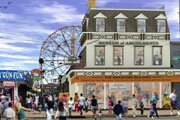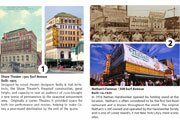FREQUENTLY ASKED QUESTIONS
Why has Save Coney Island brought a lawsuit against the City?
Save Coney Island believes that the City’s rezoning plan for Coney Island would forever destroy the dream of a revitalized, world-class Coney Island by permanently shrinking the outdoor amusement area and blocking it off with a wall of high-rise hotels that would replace historic buildings like Nathan’s Famous. We have brought a lawsuit because, now that the city’s plan has been passed by the City Council, it is the only way to prevent the plan from being implemented and to keep the dream of a world-class amusement area alive.
Isn’t the City’s plan a done deal?
That is for the Courts to decide. The City’s rezoning plan for Coney Island passed the City Council in July 2009, but our lawyers believe the City’s environmental review was inadequate and Save Coney Island is asking the Court to overturn the rezoning.
What’s the basis of Save Coney Island’s lawsuit?
That the city failed to perform the environmental review to the required legal standard. For example, the City failed to adequately study a meaningful alternative to their proposed plan, or to properly consider the impacts of the high-rise hotels on the pedestrian experience at Coney Island. Save Coney Island believes that because the City failed to conduct an adequate environmental review, the City’s rezoning plan is not lawful and should be overturned.
Does Save Coney Island oppose everything the City is doing in Coney Island?
Absolutely not. The City has taken several steps that we fully support. We strongly supported the City’s purchase of land to create a publicly-owned amusement area – in fact, we believe it should buy more land. We also support the City’s efforts to bring immediate programming to Coney Island such as the Ringling Brothers Circus. But we are opposed to the City’s development plan for Coney Island because we believe it would permanently squander Coney Island’s tremendous potential.
The City says they are planning a 27-acre entertainment area in Coney Island. That sounds big.
Of the 27 acres, 15 acres would be taken up with Times Square-style uses like high-rise hotels and indoor shopping and entertainment that we believe should not be at the core of the Coney Island experience. Only 12 acres would actually be outdoor amusements of the kind recognizable as traditional seaside entertainment.
Still, 12 acres of outdoor amusements sounds like a lot.
Not for a city the size of New York. The Municipal Art Society of New York commissioned an economic study that concluded that a revitalized Coney Island could draw a minimum of 3.5M visitors annually, but that its amusement area would need to be at least 25 acres to support this kind of attendance and ideally far larger. Almost all independent experts — from the CEO of Tivoli Gardens to the New York Times Editorial Board — agree that the City’s proposed amusement area simply would not be big enough to serve the market of New Yorkers and tourists who would visit Coney Island.
Your group opposes the high-rise hotels on the south side of Surf Avenue. But hotels were historically in Coney Island in the early 20th century. Aren’t they appropriate in Coney Island today?
Hotels absolutely belong in Coney Island, but the City has permitted high-rise hotels on sites that contain historic buildings, like Nathan’s Famous, along the south side of Surf Avenue, where they would block views and access to the beach, the boardwalk and amusements. That wall of high-rises would destroy Coney Island’s sense of openness and horizon and encroach on the already limited amount of space allocated to outdoor amusements. The hotels should be relocated north of Surf Avenue or west of KeySpan Park.
The City says that building high-rise hotels directly adjacent to the amusement area is the only way to make the amusement area in Coney Island economically viable.
This is simply not true. While there is developer interest in building high-rise buildings where the city proposes them, there is enormous interest on the part of amusement operators in operating rides, restaurants, stage-shows and other traditional seaside entertainment in Coney Island that in no way requires the presence of hotels directly adjacent to be profitable. In fact, the opposite is true: highrise buildings would actually diminish the economic viability of the Coney Island amusement area by making it less accessible and less attractive to visitors.
Isn’t supporting the city’s plan the best way to get something to happen out in Coney?
We support the City’s efforts to bring interim programming to Coney Island, like Ringling Brothers Circus. But we do not support the City’s short-sighted plan of development for the sake of development. We do not support the senseless squandering of Coney Island’s potential to become once more a world-class amusement destination.
Does Save Coney Island want to keep Coney Island just the way it is?
No. We believe that Coney Island needs new programming and new development, but as part of a plan that truly restores the amusement area to its former status as the Playground of the World.
Isn’t it a choice between implementing the City’s plan or nothing happening?
Absolutely not. This is a false choice. Entertainment operators from around the world are eager to be involved in Coney Island. A plan with a bigger amusement area would draw more commercial interest, not less.
What kind of development does Save Coney Island want to see in Coney Island?
First and foremost, we want to see as large an amusement park as possible with a mixture of rides and spectacle to create a world-class, innovative experience for visitors – a contemporary version of the experience visitors had from the early 1900s through the 1950s.
Second, we want to see the low-rise character of the South Side of Surf avenue maintained by preserving and reusing the historic buildings there as of a historic district so the amusement area will always be inviting and open to the sky. We believe high-rise hotels and indoor entertainment should be located north of Surf Avenue and west of Keyspan Park.
Finally, over the long-term we would like to see, dramatic improvements to the Aquarium, restored express train service to Stillwell Avenue, support and incentives for local entrepreneurs and artists, the Shore Theater restored as a venue for performing arts, ferry service from Manhattan, and much more. Generally, we want to see a Coney Island that celebrates its unique heritage but also has an innovative, 21st century edge with one foot in the past and one foot in the future.
Won’t the City’s plan address local community needs like affordable housing, retail and jobs?
Only to a very limited extent; and only 10 to 15 years from now. The Coney Island community has been grossly neglected over the years and has serious needs that must be addressed today. The City has been successful in persuading some local residents that redeveloping the amusement area with other uses will address their needs. However, the construction jobs the city’s plan would create would almost certainly go mainly to residents outside of Coney Island. The housing created would not be affordable to most Coney Island residents.
Save Coney Island believes that by restoring the amusement area to its status as world-class entertainment destination will actually address local community needs far more than the City’s plan. For example, a world-class amusement destination will substantially improve the image and therefore the safety of Coney Island. It will create far more jobs and act as a far superior economic engine than the City’s limited plan.
Ultimately, however, city services are the entitlement of every city neighborhood and are not dependent on private local development. The problems of the Coney Island community need to be handled at a larger scale, through a mix of targeted and city-wide programs that address needs such as safety, employment and improved infrastructure.


